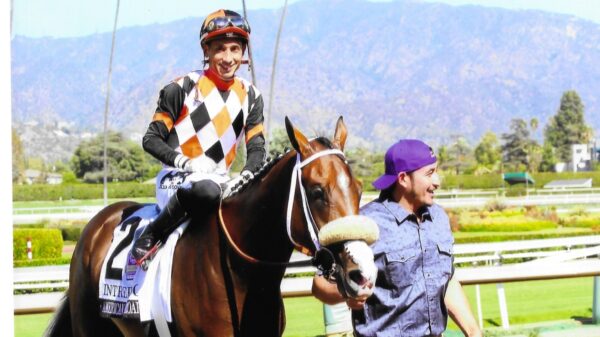
Rinaldo Del Gallo, III
By: Rinaldo Del Gallo, III
Yes, the Belmont Stakes will be run at Saratoga at 10 furlongs, not Belmont (which is under reconstruction) at 12 furlongs. For those that don’t know, a furlong is a distance almost only used in horse racing these days and is equal to 1/8 (one eighth) of a mile.
With one exception (the 2020 Covid Belmont won by Tiz the Law at 9 furlongs), the Belmont has been run at 12 furlongs at Belmont.
Some major points:
1. The “Belmont Stakes” is named after the person August Belmont, not the race track, and was known as the Belmont Stakes long before Belmont Park was ever built.
2. Saratoga represents the fifth race track the Belmont has been held at—it is the first time the race has been run there, probably in a large part due to the fact that Saratoga is a summer meet whereas the Belmont is typically held in early June, before Saratoga opens.
3. The Belmont Stakes ran 23 times at Jerome Park, from 1867 until 1889. Jerome Park was in operation from 1866 until 1894, according to Wikipedia. Thus, the Belmont Stakes left Jerome Park five years before Jerome Park’s closing. The first year of the Belmont’s running was 1867, and Jerome Park opened in 1866. The first 7 Belmont Stakes were run at 13 furlongs, a furlong more than the usual 12 furlongs.
4. The first time the Belmont was run at 12 furlongs, a horse named Saxon won it. The year was 1874. Saxon is unusual in that he was born in Great Britain. It would be much later, 1917, when the first foreign born horse won the Kentucky Derby (Omar Khayyam, also from Great Britain). The horse that came in second, Grinstead, was a son of Lexington, would have a son named Volante, who in turn would have a son named Hindus that won the 1900 Preakness and would be the last time a Lexington-sire line horse won an American classic. Volante came out of the same female family that produced Americus and Norfolk, that had such a tremendous influence on the thoroughbred.
5. Morris Park, also part of modern New York City (what is now the Bronx) was short lived but had a storied history. Morris Park Racecourse was an American thoroughbred horse racing facility from 1889 to 1904. Like Jerome Park, the Belmont Stakes was moved before the closing year of Morris Park.
6. The Belmont has been run at 10 furlongs six times, as this year will be its 7th run at that distance. The first three runnings of the Belmont Stakes at 10 furlongs were 1890, 1891, and 1892. These were all at Morris Park. More on that 10 furlong distance in paragraph 9.
7. In the 1892 running won by Patron, only 2 ran—there has never been a walkover. This happened 4 other times, 5 in total. Only 2 ran in 1887 in the Belmont won by Hanover (influential in the breed). Only 2 ran in the 1888 Belmont won by Sir Dixon (influential in the breed). Finally, only two ran in the 1910 Belmont Stakes won by Sweep (influential in the breed). Only 2 ran in the 1920 Belmont Stakes won by Man O’War (also influential in the breed, and a sire of 3 Belmont winners).
8. The Belmont Stakes ran three times at 9 furlongs. The aforementioned COVID Belmont won the Tiz the Law in 2020. The other two 9 furlong Belmonts were in 1893 at Morris Park (Comanche), and in 1894 at Morris Park (Henry of Navarre). Comanche (sired by a horse bred in New Zealand by the name of Sir Modred) left no offspring. Henry of Navarre was inducted in the Hall of Fame in 1985. I believe I occasionally see him in pedigree through his daughter Saratoga Belle, High Feather, and Orienta (from which Shut Out descends in tail female). Shut Out was to win the Kentucky Derby, Belmont and Travers.
9. There have been six (6) runnings of the Belmont Stakes at 10 furlongs in addition to this year’s 10 furlong Belmont at Saratoga:
i. 1890 won by Burlington, at Morris Park, the first year the Belmont was at Morris Park.
ii. 1891 won by Foxford at Morris Park
iii. 1892 won by Patron at Morris Park
iv. 1895 winner Belmar (sired by multiple stakes winner Belvidere, a full brother to Sir Dixon). I have not researched it, but while Sir Dixon is influential (this I know), I believe (without research) Belvidere was not influential in the long term development of the breed, though Belmar won the Preakness and Belmont. When Belmar won the Preakness, the race was at Gravesend New York at 8.5 (not 9.5) furlongs. Thus Belmar won two American classics at distances the races are not usually run today
v. The 1904 winner Delhi who won the Belmont the last year it was run at Morris Park. I see a fair amount of Delhi in the bree
vi. The 1905 Belmont won by Tanya, the second filly to win the Belmont (Ruthless won the first one. The 1905 Belmont was the first time the Belmont was run at Belmont Park. Perhaps it is fitting that the first Belmont—Ruthless in 1867, and the first race run at Belmont Park, Tanya in 1905, were won by fillies. Tanya’s Belmont was to be the last Belmont run at 10 furlongs until this year’s 2024 Belmont at Saratoga.
10. 2024 was not the first time the Belmont Stakes were moved because Belmont was being repaired. Five were run at Aqueduct in the 60’s.
i. The 1963 Belmont won by Chateaugay (won the Kentucky Derby, second in the Preakness)
ii. The 1964 Belmont won by Quadrangle (Northern Dancer 3rd)
iii. The 1965 Belmont won by Hail to All (Tom Rolphe second, First Family—a little know son of SomethingRoyal, dam of Secretariat and Sir Gaylord)
iv. The 1966 Belmont winner Amberoid
v. The 1967 Belmont winner Damascus.
11. The first 7 runnings of the Belmont were at 13 furlongs at Jerome Park. Then from 1874 to 1889, the Belmont was run at 12 furlongs (16 runnings.) The Belmont would not be run at 12 furlongs again until 1926, when Man O’War’s son Crusader won it. 12 furlongs at Belmont Park, three weeks after the Preakness eventually became the standard.
12. In fact 26 times the Belmont was run at 11 furlongs. It was 11 furlongs 8 times during the Morris Park years of 1896-1903. It was 11 furlongs at Belmont Park itself from 1906 (the second running of the Belmont Stakes at Belmont Park) to the1925 Belmont won by Man O’War’s son American Flag. American Flag became the sire of the second dam of Raise a Native, a highly influential horse in the breed. That makes 20 runnings of an 11 furlong Belmont at Belmont Park. When Sir Barton won the Belmont in 1919, winning what would eventually be called the “Triple Crown,” he did so at 11 furlongs and set a New World Record for that distance. Only three ran in Sir Barton’s Belmont. Man O’War’s Belmont was at 11 furlongs.
13. As discussed, after the Belmont Stakes has been run at Saratoga, that will be the 5 racetrack the Belmont will have been run at:
a. Jerome Park from 1867-1889 (first 23 Belmont Stakes)
b. Morris Park from 1890-1904 (16 times)
c. Belmont Park from 1905-1962, 1968-2023) (79 times)
d. Aqueduct from 1963-1967 (7 times) when Belmont was being repaired.
e. Saratoga 2024.
The race was not run in 1911 and 1912, when New York Tracks were having problems with the legislature.
14. Of note, the seven times the Belmont Stakes was run at Aqueduct, it was run at its traditional length of 12 furlongs (1 ½ miles). Much has been written about how the 1 ¼ 2024 Belmont does not reflect the usual 1 ½ mile distance. This ¼ of a mile difference in length is a major change in the race. To be frank, I have not spent a lot of time trying to figure out whether a 1 ½ mile dirt race would be possible at Saratoga. I notice with Equibase, there just is no track record for 1 ½ miles on dirt. Arrogate set the 1 ¼ track record in his 2016 Travers. There is a 1 5/8 record for Green Highlander in 1991—the gelded son of Green Dancer went on to be a hurdler. There is a 1 ¾ mile record Curling’s son King Zachary when he won the BirdStone stakes, who apparently broke a 91-year-old stakes record set by Reigh Count in the 1928 Saratoga Cup—a race ran with only two runners but the other being the great Display. I believe the issue was that while 1 5/8 and 1 6/8 races can be on a straight away, albeit with a short distance to a curve, 1 ½ would have to be on a curb itself. To be truthful, I have not studied the track conformation enough to have a public opinion, but you can look at the Birdstone itself and conclude whether or not you think 1 ½ miles is viable. Of note, a gelding by the name of James Boswell, closely related to great horses, set the 2 mile dirt record in August of 1983. Regardless, while I know that Saratoga has run races longer than 1 ½ miles on dirt and there are track records to prove it, there is no track record for 1 ½ miles on dirt, leading me to believe there is reason for the lack of the record. The turf course can handle a 1 ½ mile race.
https://www.equibase.com/premium/eqbTrackRecords.cfm?trk=SAR&cy=USA
Video below: King Zachary’s Saratoga 14 furlong record setting BirdStone Stakes:
15. There is a “Wilton Chute” that opened up a Saratoga. According to newspaper sources it opened in 2022 and was first used in 1902 and last used in 1972 when it was closed to make parking spaces. This Wilson apparently “allow one-mile races to be run on the main dirt track during the summer meet.” According to ESPN, “The Wilson Chute was named for Richard T. Wilson, a banker and president of the Saratoga Racing Association in the early years of the 20th century. He was among a group of investors who purchased Saratoga Race Course in 1900 and oversaw major capital improvements to the track’s facilities.” At any rate, the Wilson Chute—as important as it may be—only restores what was already there, and it appears Saratoga never had 1 ½ mile races on dirt if Equibase is to be believed.
16. Of course, a 1 ½ mile race on the dirt race at Saratoga is “possible.” But that would probably involve starting on a curve, ending on a curve, and/or not having the race finish at the typical finish line. This simply may not have been acceptable.
17. Another Belmont oddity. “In the United States all race tracks (horses and auto) are counterclockwise (left-handed), although the Belmont Park track was right-handed until 1921. (Man o’ War’s victory at the 1920 Belmont Stakes was run right-handed.)” (Source: the German way and More). In fact, when you look at a video of Man O’War’s win in the Dwyer, you can see the horse and jockey’s right shoulder (the viewer’s left) are closes to the track, indicating he was running counterclockwise. According to Wikipedia, “Before 1921, the race was run in the clockwise tradition of English racing. Since then, the race has been run in the American, or counter-clockwise, direction.” I do not know if this applies to the races run at Jerome Park or Morris Park. BelmontStakes.com reports, “The 1921 Belmont was the first to be run in the counterclockwise direction.” The same source also makes the claim, “The first post parade in the United States — wherein the horses walk sequentially before the crowd — was prior to the 1871 Belmont Stakes race.” Thoroughbredracing.com states, “The first president of The Jockey Club, Belmont Jr. was a bold leader; he would go on to be credited with saving racing in New York after it shut down for nearly three years because of anti-gambling laws, and at his new racecourse, horses would not run in the conventional (on these shores) counter-clockwise direction. They would follow the English model and run clockwise, and the horses in the Belmont Stakes would go to the post on the training track, located directly to the east of the main track, leading a New York Times scribe to write in 1906 that the start was so far away that ‘the great majority of spectators hardly knew where to look for the horses.’”
VIDEO BELOW: Starting at 10 Seconds, there is a video of Man O’War winning the Dwyer Stakes at Belmont. Notice he is running clockwise, not the usual counter-clockwise. I believe this film and a few viewing angles of Man O’War beating Sir Barton are the only films that exist of Man O’War racing.
VIDEO BELOW: 1920 Belmont Futurity–note how it is run clockwise, as in Europe
CONCLUSION: So, no, the Belmont Stakes was not always run at Belmont Park. Saratoga is the fifth race track the race has been run at, joining Jerome Park, Morris Park, Belmont Park and Aqueduct. The Belmont Stakes has been at various distances, 9 furlongs (3 times, the COVID Belmont and 2 races at Morris Park), 10 furlongs (6 times, 7 if you include 2024), 11 furlongs (26 times), 13 furlongs (7 times, constituting the first 7 races), and 12 furlongs 113 times (Jerome Park and Belmont Park). And believe it or not, the Belmont Stakes has even been run clockwise like they do in Europe. That 2015 Thoroughbredracing.com article said, “Four tracks, five distances, two directions, a handful of configurations. In light of the Belmont Stakes’ tradition of modification, it is perhaps those who favor change that have history on their side.” Spot on—save for it is five tracks now.






